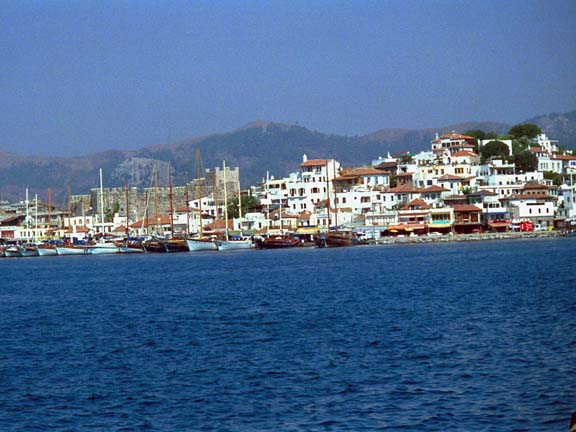
The statue of Atis with a Phrygian conical hat, bronze busts of Athena, goddess of intelligence and wisdom and of a negro, figures of Hermes, a bronze statue of the god Apollonius found in Seleukea, a plate displaying Athena in relief, made of solid silver, rings, earrings, bracelets, brooches, medallions, necklaces and fibula made of gold and precious stones, ceramic and bronze oil lamps, inscriptions and vessels with figures in relief as well as various jewellery and glass articles are on display. Underwater findings, on the other hand, mainly consist of various anchors made of stone and iron, antique amphorae, used for carrying liquids and various vessels. The other showcases display stone statuettes and unguentaria. In the Emperors Hall, in addition to the large size statues of the emperors such as Traian, Hadrianus and Augustus of the Roman era, there are also the statues of the empresses Sabina, Lulia Donna and Plancia Manga. The statues of the famous Three Beauties and the female dancer made of black and white marble are interesting examples. In the Tomb Cults Hall, sarcophagi and reliefs depicting the burial tradition are displayed. The first sarcophagus in the sarcophagi hall belongs to Damitlas Filskas and his family. It consists of a massive coffin and its lid. On the lid the husband and wife are depicted lying on a klinidion (small bed). The sarcophagus with a medallion is immediately to the left of this sarcophagus. There is a medusa’s head in a wreath at one end of the sarcophagus, in the centre, and Eros figures on the sides. The scenes on the sarcophagus symbolise a life filled with success and happiness. To the rear of the hall, there are two sarcophagi ornamented with figures illustrating various moments from the mythological life of Herakles. Additionally, there are 2 sarcophagi from Girland. One of the most striking mosaics on display in the Mosaic and Icons Hall is undoubtedly the Mosaic of Philosophers found in Seleukia around the edge of which the most reputed thinkers, orators, historians and mathematicians of the Antiquity such as Salon, Tykydires, Lykuyrgos, Herodotos, Hesiodos, Demostenes and Pytagoras are included together with their names. Moreover, the Akhilleus Mosaic found in Xanthos is well worth a visit. At the rear part of this section is the treasure of Korydalla/Kumluca. The Icons compiled from various churches primarily being St. Nicholas in Demre are displayed in the southern part of the hall. The icons here include instants from the lives of Jesus Christ and Virgin Mary, Genesis, The Last Supper, Day of Judgement, Death of Holy Virgin/Koimesis, Christ Almighty, 12 Apostles, Baptism, Crucifixion, Miracles and two portraits of Father Christmas and the relics alleged to contain his bones. In the Coins Hall, the Anatolian Minting tradition, technique and economy of 2500 years dating back from the 6th century B.C. until the present day are observed in an educational sequence. Furthermore, Phrygian and Lydian coins as well as Elmalı coins found in the area and in Western Anatolia are displayed in the coins hall. In the Ethnography Hall, various artefacts such as regional art, clothing, handwritten books and weapons and vessels from the Seljuk, Ottoman and Republican eras are on display. In addition, chinaware, porcelain, religious artefacts, padlocks, long dresses with floral decoration and Yörük items are exhibited. In the middle of the Perge Hall, adjacent to the cinevision hall which has 4 Niches on the right and 3 on the left, is the Marsyas statue on a revolving pedestal around which are statues of gods, unearthed at the Perge theatre. The upper part of the wall displays friezes found at Perge theatre. At the furthest end is the Lycian Hall, with an outer façade built in the architectural style of the Lycian sarcophagi, in which findings from the Lycian era are displayed. Large pieces, such as sarcophagi, tombs, tombstones and statues which cannot be displayed inside, are displayed in the Open Air Gallery. The SUNA-İNAN KIRAÇ MEDITERRANEAN CIVILIZATIONS MUSEUM, Ayayorgi Church, built during the 17th century by the Karamanids, who were of Turkish origin and adopted the Orthodox faith, has recently been restored and transformed into a museum complex consisting of an ethnography museum, research library, photograph, document, archive and conference hall. The ATATÜRK HOUSE MUSEUM is the house which was allocated to Atatürk when he visited Antalya on March 6, 1930 and subsequently transformed into a museum where furnishings of that period as well as articles belonging to Atatürk were preserved.




No comments:
Post a Comment